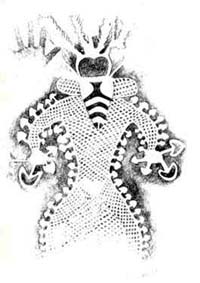![]()
![]()
xvii. The Point of Creation

There is now overwhelming anthropological, epigraphical and scientific evidence to demonstrate that a high percentage of Upper Palaeolithic cave art in Western Europe depicts shamans in altered states of consciousness. It shows also expressions of their hallucinatory visions, which include everything from abstract geometric forms to chimeras (purely animal hybrids), therianthropes (human-animal hybrids), and other types of perceived spirit intelligences. What is more, there is every reason to suppose that these encounters were initiated by the oral ingestion of psychedelic plants and/or mycetes, i.e. psychoactive mushrooms.
|
Indeed, the drug of choice for the Palaeolithic shaman in Europe was most probably a mushroom from the Psilocybe genus, which contains high dosages of Psilocybin, an active ingredient that induces vivid psychedelic experiences. The early use of mushrooms for this purpose is evident from prehistoric rock art in the Tassili mountains of Algeria, which dates to 7000-5000 BC. It is from this region of the Sahara that the Dogon tribe are thought to have come prior to their southerly migration to more fertile regions on the River Niger in what is today Mali. Further examples of rock art from Siberia, dating to c. 4000 BC, show spirits or shamans with mushrooms on their heads. These are likely to be the species Amanita muscaria, which was used extensively by Tungus Reindeer shamans to induce trance states. The overwhelming evidence of mushroom use in prehistoric times indicates that the Well Scene at Lascaux might indeed depict a shaman in a trance state induced by psychedelic substances. Could this be the origin of some sort of death cult, whereby the initiate was brought very close to physical death in order that they might experience the otherworld, the place of the afterlife? |
Rock art from the Tassili mountains of Algeria showing a therianthorpe with mushrooms in his hands and around his body. |
As already shown, the Early Neolithic peoples of South-east Turkey practised their own death cult, symbolised by the vulture, seen most likely as a personification of Cygnus as the celestial bird atop the cosmic axis. Thus it is no surprise to find that there are various examples of symbolic art showing mushrooms in association with key shamanic symbols such as the vulture, serpent and egg at the Pre-Pottery Neolithic sites of Southeast Turkey.
Quite separate to this hard evidence of mushroom consumption during the Early Neolithic era, is the work of celebrated Semitic language scholar and Dead Sea Scrolls expert John Allegro. He put his career on the line in 1970 when he published details of widespread philological evidence of a mushroom-based cult of creation encoded within the Sumerian and Akkadian languages. Their joint civilization, arguably the oldest anywhere in the world, sprang from the Early Neolithic culture responsible for sites such as Göbekli Tepe and Karahan Tepe. Allegro associated this mushroom cult directly with the symbol of the swan (and the stork), which he saw as a representation of the female reproductive parts. Even though he only recognised the origins of this cult as going back to 4000 BC, it can be traced back to Palaeolithic times, with the most common themes cosmic life and death.
Cygnus was the original destination of the shamanic journey, as well as the deemed place of cosmic creation. Yet why was Cygnus seen in this role, long after the end of the Palaeolithic age, which coincided with the cessation of the last Ice Age, c. 9500-8500 BC? Did later Neolithic priest-shamans merely continue to venerate Deneb and the stars of Cygnus since they wished to follow well-established astronomical beliefs held true by their ancestors, or was there something more profound behind their knowledge of these crucially important stars?
![]()
![]()
